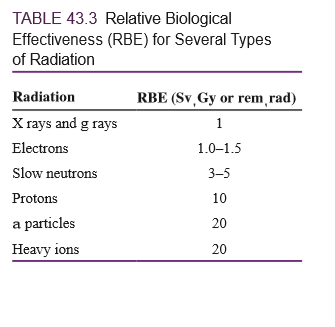TABLE 43.3 Relative Biological Effectiveness (RBE) for Several Types of Radiation Radiation RBE (Sv, Gy or rem rad) X rays and g rays 1 Electrons 1.0–1.5 Slow neutrons 3-5 Protons 10 a particles 20 Heavy ions 20
TABLE 43.3 Relative Biological Effectiveness (RBE) for Several Types of Radiation Radiation RBE (Sv, Gy or rem rad) X rays and g rays 1 Electrons 1.0–1.5 Slow neutrons 3-5 Protons 10 a particles 20 Heavy ions 20
Related questions
Question
Beams of p- mesons are used in radiation therapy for certain cancers. The energy comes from the complete decay of the p- to stable particles. (a) Write out the complete decay of a p- meson to stable particles. What are these particles? (b) How much energy is released from the complete decay of a single p- meson to stable particles? (You can ignore the very small masses of the neutrinos.) (c) How many p- mesons need to decay to give a dose of 50.0 Gy to 10.0 g of tissue? (d) What would be the equivalent dose in part (c) in Sv and in rem? Consult Table 43.3 and use the largest appropriate RBE for the particles involved in this decay.

Transcribed Image Text:TABLE 43.3 Relative Biological
Effectiveness (RBE) for Several Types
of Radiation
Radiation
RBE (Sv, Gy or rem rad)
X rays and g rays
1
Electrons
1.0–1.5
Slow neutrons
3-5
Protons
10
a particles
20
Heavy ions
20
Expert Solution
This question has been solved!
Explore an expertly crafted, step-by-step solution for a thorough understanding of key concepts.
This is a popular solution!
Trending now
This is a popular solution!
Step by step
Solved in 5 steps
